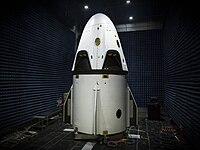Dragon V2

Dragon 2 spacecraft in a test chamber on top of a trunk.
|
|
| Description | |
|---|---|
| Role | Placing humans and cargo into Low Earth orbit (commercial use) and ISS commercial taxi CCtCap (government use), space colonization (planned) |
| Crew | 7 (max. capacity) |
| Launch vehicle |
Falcon 9 (into orbit) Falcon Heavy (to the Moon) |
| Dimensions | |
| Height | 8.1 metres (27 ft) with trunk |
| Diameter | 3.7 metres (12 ft) with trunk |
| Sidewall angle | 15 degrees |
| Volume | 10 m3 (350 cu ft) pressurized 14 m3 (490 cu ft) unpressurized |
| Dry mass | about 6,400 kg (14,000 lb) |
| Payload | to ISS 3,310 kg (7,300 lb). It can return to Earth up to 2,500 kg (5,500 lb) |
| Miscellaneous | |
| Endurance | 1 week to 2 years |
| Re-entry at | 3.5 G |
| Thrusters | 8 x SuperDraco positioned around the perimeter of the vehicle in 4 pairs called “jet packs” and 18 in-space maneuvering Draco thrusters. |
| Propellant | NTO/MMH |
Dragon 2 (also Crew Dragon, Dragon V2, or formerly DragonRider) is the second version of the SpaceX Dragon spacecraft, which will be a human-rated vehicle able to make a terrestrial soft landing. It includes a set of four side-mounted thruster pods with two SuperDraco engines each, which can serve as a launch escape system (or launch abort system (LAS)) or be used for propulsive landings. Also, it has much larger windows, landing legs which extend from the bottom of the spacecraft, new flight computers and avionics, and redesigned solar arrays, all packaged in a spacecraft with a changed outer mold line from the initial cargo Dragon that has been flying for several years.
The spacecraft was unveiled on May 29, 2014 during a press event at SpaceX headquarters in Hawthorne, California. Designed to ferry astronauts to space, the capsule differs considerably from the cargo-carrying Dragon, which has been operational since 2010. Dragon 2 is scheduled to make an unmanned first orbital flight in November 2017, and to carry its first astronaut crew in May 2018. SpaceX completed a launch pad abort test of the spacecraft on 6 May 2015 and a hovering test on 24 November 2015.
NASA has signed a contract to procure up to six crewed flights to the International Space Station under the Commercial Crew Development.
The crewed variant of Dragon was initially called DragonRider. It was intended from the beginning to support a crew of seven or a combination of crew and cargo. It was planned to be able to perform fully autonomous rendezvous and docking with manual override ability; and was designed to use the NASA Docking System (NDS) to dock to the ISS. For typical missions, DragonRider would remain docked to the ISS for a period of 180 days, but would be designed to be able to do so for 210 days, the same as the Russian Soyuz spacecraft. From the earliest design concepts which were publicly released in 2010, SpaceX planned to use an integrated pusher launch escape system for the Dragon spacecraft, claiming several advantages over the tractor detachable tower approach used on most prior crewed spacecraft. These advantages include the provision for crew escape all the way to orbit, reusability of the escape system, improved crew safety due to eliminating a stage separation, and the ability to use the escape engines during landings for a precise solid earth landing of the capsule. An emergency parachute system will be retained as both a redundant backup and for water landings.
...
Wikipedia
